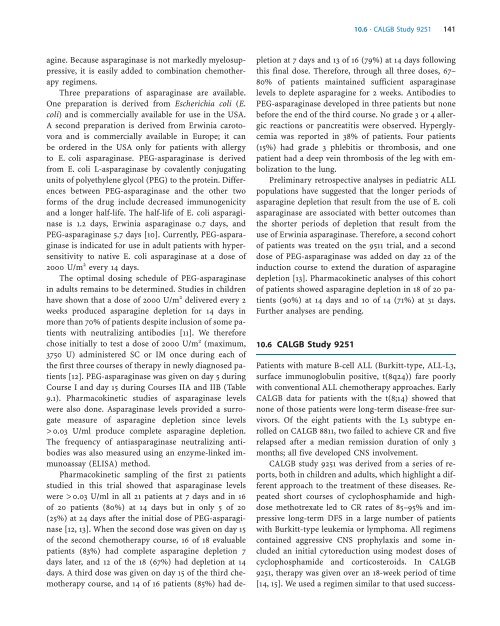Acute Leukemias - Republican Scientific Medical Library
Acute Leukemias - Republican Scientific Medical Library
Acute Leukemias - Republican Scientific Medical Library
You also want an ePaper? Increase the reach of your titles
YUMPU automatically turns print PDFs into web optimized ePapers that Google loves.
a 10.6 · CALGB Study 9251 141<br />
agine. Because asparaginase is not markedly myelosuppressive,<br />
it is easily added to combination chemotherapy<br />
regimens.<br />
Three preparations of asparaginase are available.<br />
One preparation is derived from Escherichia coli (E.<br />
coli) and is commercially available for use in the USA.<br />
A second preparation is derived from Erwinia carotovora<br />
and is commercially available in Europe; it can<br />
be ordered in the USA only for patients with allergy<br />
to E. coli asparaginase. PEG-asparaginase is derived<br />
from E. coli L-asparaginase by covalently conjugating<br />
units of polyethylene glycol (PEG) to the protein. Differences<br />
between PEG-asparaginase and the other two<br />
forms of the drug include decreased immunogenicity<br />
and a longer half-life. The half-life of E. coli asparaginase<br />
is 1.2 days, Erwinia asparaginase 0.7 days, and<br />
PEG-asparaginase 5.7 days [10]. Currently, PEG-asparaginase<br />
is indicated for use in adult patients with hypersensitivity<br />
to native E. coli asparaginase at a dose of<br />
2000 U/m 2 every 14 days.<br />
The optimal dosing schedule of PEG-asparaginase<br />
in adults remains to be determined. Studies in children<br />
have shown that a dose of 2000 U/m 2 delivered every 2<br />
weeks produced asparagine depletion for 14 days in<br />
more than 70% of patients despite inclusion of some patients<br />
with neutralizing antibodies [11]. We therefore<br />
chose initially to test a dose of 2000 U/m 2 (maximum,<br />
3750 U) administered SC or IM once during each of<br />
the first three courses of therapy in newly diagnosed patients<br />
[12]. PEG-asparaginase was given on day 5 during<br />
Course I and day 15 during Courses IIA and IIB (Table<br />
9.1). Pharmacokinetic studies of asparaginase levels<br />
were also done. Asparaginase levels provided a surrogate<br />
measure of asparagine depletion since levels<br />
> 0.03 U/ml produce complete asparagine depletion.<br />
The frequency of antiasparaginase neutralizing antibodies<br />
was also measured using an enzyme-linked immunoassay<br />
(ELISA) method.<br />
Pharmacokinetic sampling of the first 21 patients<br />
studied in this trial showed that asparaginase levels<br />
were >0.03 U/ml in all 21 patients at 7 days and in 16<br />
of 20 patients (80%) at 14 days but in only 5 of 20<br />
(25%) at 24 days after the initial dose of PEG-asparaginase<br />
[12, 13]. When the second dose was given on day 15<br />
of the second chemotherapy course, 16 of 18 evaluable<br />
patients (83%) had complete asparagine depletion 7<br />
days later, and 12 of the 18 (67%) had depletion at 14<br />
days. A third dose was given on day 15 of the third chemotherapy<br />
course, and 14 of 16 patients (85%) had de-<br />
pletion at 7 days and 13 of 16 (79%) at 14 days following<br />
this final dose. Therefore, through all three doses, 67–<br />
80% of patients maintained sufficient asparaginase<br />
levels to deplete asparagine for 2 weeks. Antibodies to<br />
PEG-asparaginase developed in three patients but none<br />
before the end of the third course. No grade 3 or 4 allergic<br />
reactions or pancreatitis were observed. Hyperglycemia<br />
was reported in 38% of patients. Four patients<br />
(15%) had grade 3 phlebitis or thrombosis, and one<br />
patient had a deep vein thrombosis of the leg with embolization<br />
to the lung.<br />
Preliminary retrospective analyses in pediatric ALL<br />
populations have suggested that the longer periods of<br />
asparagine depletion that result from the use of E. coli<br />
asparaginase are associated with better outcomes than<br />
the shorter periods of depletion that result from the<br />
use of Erwinia asparaginase. Therefore, a second cohort<br />
of patients was treated on the 9511 trial, and a second<br />
dose of PEG-asparaginase was added on day 22 of the<br />
induction course to extend the duration of asparagine<br />
depletion [13]. Pharmacokinetic analyses of this cohort<br />
of patients showed asparagine depletion in 18 of 20 patients<br />
(90%) at 14 days and 10 of 14 (71%) at 31 days.<br />
Further analyses are pending.<br />
10.6 CALGB Study 9251<br />
Patients with mature B-cell ALL (Burkitt-type, ALL-L3,<br />
surface immunoglobulin positive, t(8q24)) fare poorly<br />
with conventional ALL chemotherapy approaches. Early<br />
CALGB data for patients with the t(8;14) showed that<br />
none of those patients were long-term disease-free survivors.<br />
Of the eight patients with the L3 subtype enrolled<br />
on CALGB 8811, two failed to achieve CR and five<br />
relapsed after a median remission duration of only 3<br />
months; all five developed CNS involvement.<br />
CALGB study 9251 was derived from a series of reports,<br />
both in children and adults, which highlight a different<br />
approach to the treatment of these diseases. Repeated<br />
short courses of cyclophosphamide and highdose<br />
methotrexate led to CR rates of 85–95% and impressive<br />
long-term DFS in a large number of patients<br />
with Burkitt-type leukemia or lymphoma. All regimens<br />
contained aggressive CNS prophylaxis and some included<br />
an initial cytoreduction using modest doses of<br />
cyclophosphamide and corticosteroids. In CALGB<br />
9251, therapy was given over an 18-week period of time<br />
[14, 15]. We used a regimen similar to that used success
















